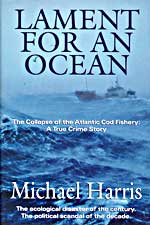At the beginning of this millennium, the Norse began to fish what is now called the Grand Banks off the coast of Newfoundland. In 1501, the Company of Adventurers to the New Found Lands was chartered in England to make summer expeditions to that rich fishing ground. For the next 500 years, the Grand Banks yielded up vast wealth. In 1981, the fishery brought in 779,000 metric tons of groundfish, mostly cod, worth $705 million. East-coast Canada boasted 29,000 registered fishing vessels and over 1,000 fish-processing plants. The fishery employed 62,000 people in 1,300 communities, 20 percent of all the jobs in Newfoundland.
Then, after 1,000 years, it was over. Not suddenly. The catch declined for 20 years. Just about everyone saw what was coming. Many issued warnings. The government imposed quotas, but the fleet couldn’t even manage to land the quotas, a blatant sign that they were set too high. Finally, in 1992, the cod fishery was essentially closed. No one knows whether it will ever recover.
If you want to assign blame for this destruction of a resource that should have been renewable forever, you can point in many directions. At the Canadian fishermen, who knew better than anyone that their golden goose was dying, yet opposed their government’s attempt to revive it. At the foreign fleets that invaded the 200-mile limit, cheated on quotas, falsified records.
Technology, so often hailed as our way out of any problem, was a direct cause of this one. Only after 1954, when the first factory trawler made its appearance on the Grand Banks (it was a British ship, rapidly followed by Russian and Spanish ones) was it actually possible to catch all the fish.
Here is how Michael Harris in his book Lament for an Ocean describes these vessels: “The net and rigging are engineered to haul fifty to sixty tons of fish at a time. One hundred tons of mature cod can be taken in just two hours by these killing machines. The huge trawl is hoisted up and with a sudden whoosh tons of cod shoot through the hatches to the factory deck below. Cod are loaded on conveyer belts that lead to the filleting machines. [The fillets are] packed into … blocks, frozen and stored. … The offal and so-called trash fish are sent to the fish-meal factory on a lower deck.
“If a vessel from a particular fleet hits a ‘hot spot,’ her captain will call in sister ships to work the shoal. As many as fifty factory-freezers will converge, fishing non-stop until nothing is left. … Electronic fish-finders, echographs, and even mini-subs are used to locate shoals of fish. The newest sonar devices can scan the ocean two miles in advance of a working trawler.”
You could blame this voracious technology, except that across the ocean another nation, equally dependent on a cod fishery, faced with the same technology, hearing the same kinds of warnings, managed to save its fishery.
In 1989, Norwegian scientists warned that the cod population in the Barents Sea was plummeting. They advised that the normal quota for the catch, about 800,000 tons, be drastically reduced. This idea was received, as in Canada, with panic, demonstrations, pleas from coastal communities, political threats. In Norway, the government hung tough. As one fisheries official said, “The main qualification to survive one week as minister of fisheries is that you have to be tough, because it’s the most unpopular occupation you could have in Norway.”
The Norwegian government slashed the cod quota, reducing fishing incomes by over 80 percent. It put a moratorium on catching caplin, the main food of the cod. It banned fishing on the spawning grounds. No one had proved that dragging huge nets through schools of spawning cod interfered with reproduction, but the Norwegians assumed that reproducing fish should be left alone, if you want fish in the future.
Both Norway and Canada are compassionate nations. They supported their fishing communities while the fisheries were down, in each case at a cost of billions of dollars. But Canada, in its compassion (and bowing to immense political pressure), closed the fishery too late and incompletely, didn’t ban fishing on spawning grounds, didn’t stop caplin fishing, and enforced its restrictions tepidly (especially on foreign vessels). Canada is still supporting its ex-fishermen. Norway no longer needs to.
After three years of Norway’s intense restrictions, the Barents Sea cod population began to rise. The government cautiously raised its quota to 248,000 tons, double the 1990 quota, but far below historic catches. By 1997, there had been such a stunning recovery that the quota went up to 850,000 tons. Unable to process that catch themselves, the Norwegians kindly sent some of it to the idle fish plants of Canada.
Given the rate at which fisheries are crashing all over the world, it is not clear that anyone is eager to learn lessons from anyone else. But I see at least two lessons from the Norwegians’ happy example — lessons that apply far beyond fisheries. One is that it is crazy to save jobs in the short term by endangering the resource upon which the jobs depend. The other is that social policy, and especially regulatory policy, must keep up with technical change. A world of powerful technology requires strong regulation. Those who wield the technology ought to be the first to demand that regulation, to ensure their own survival.


